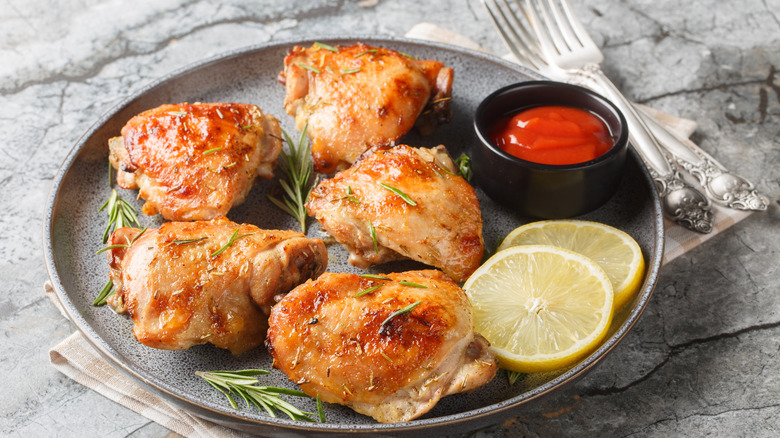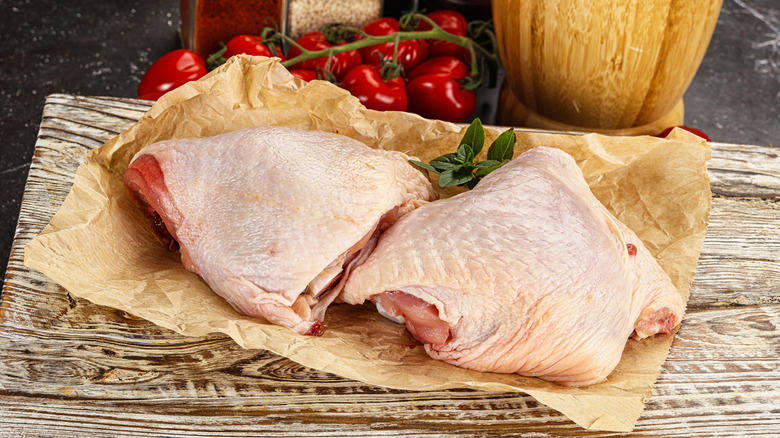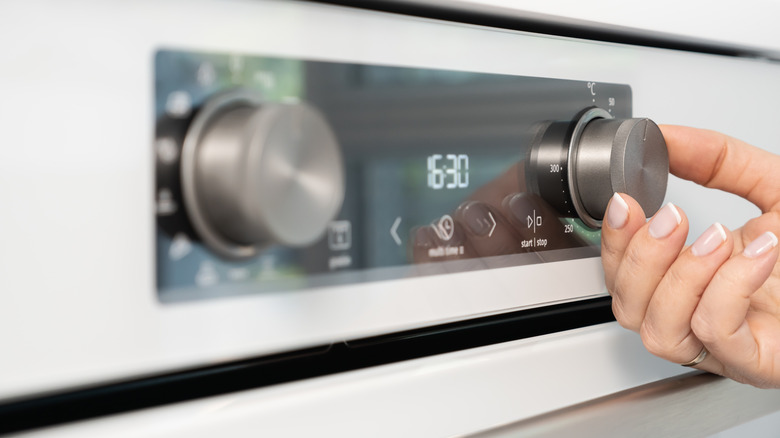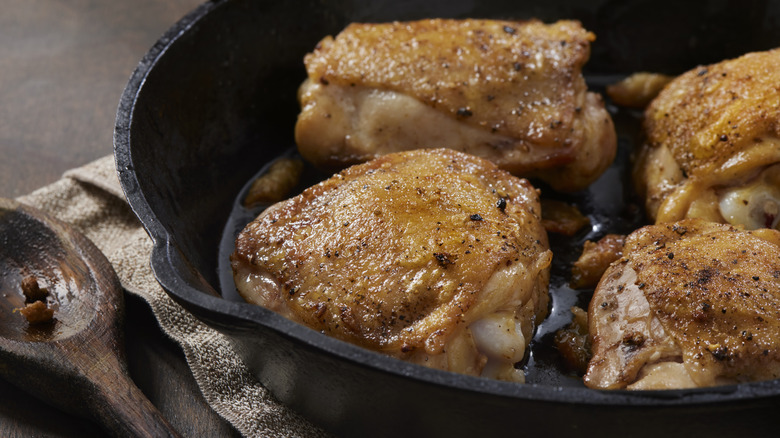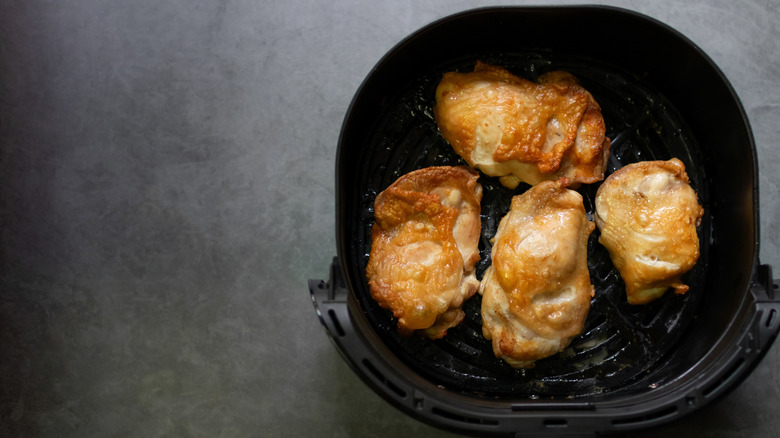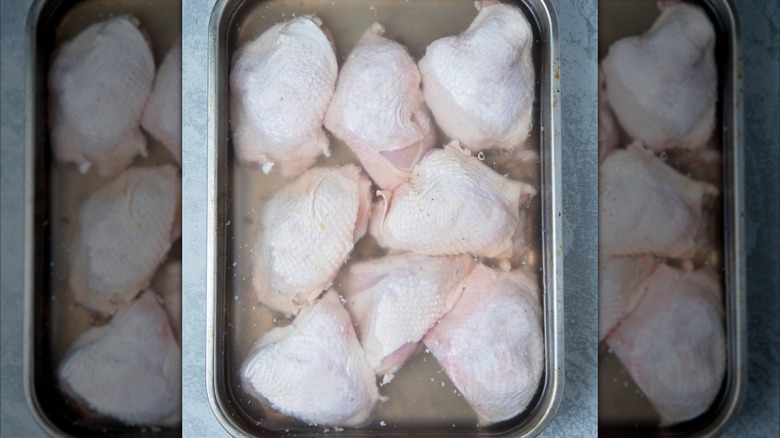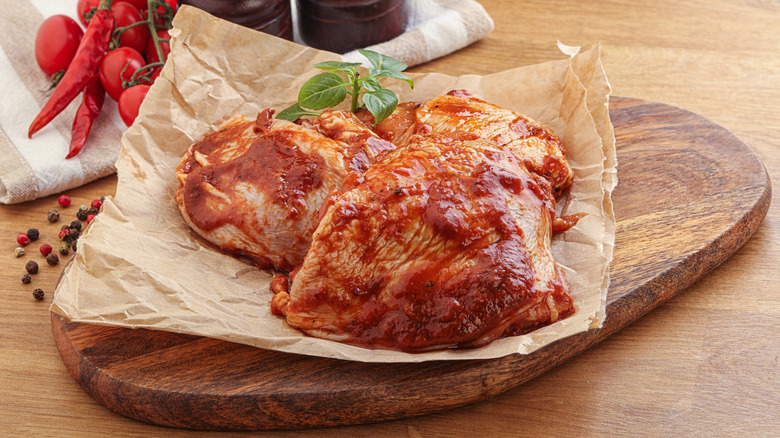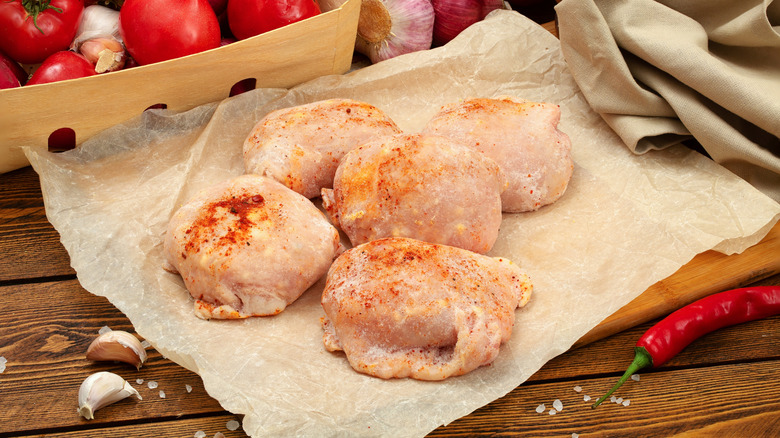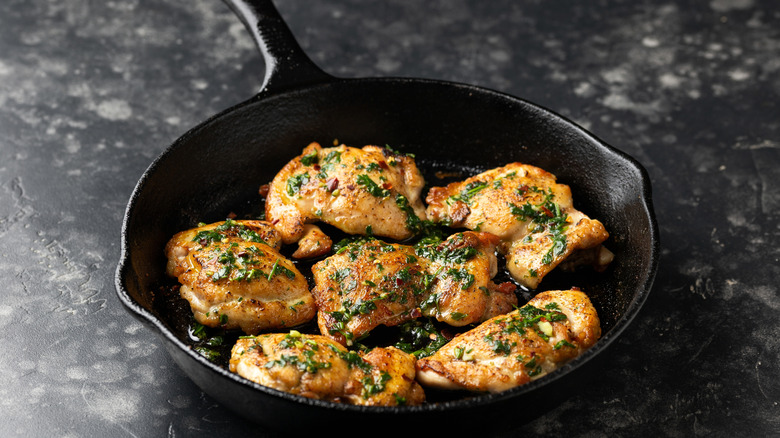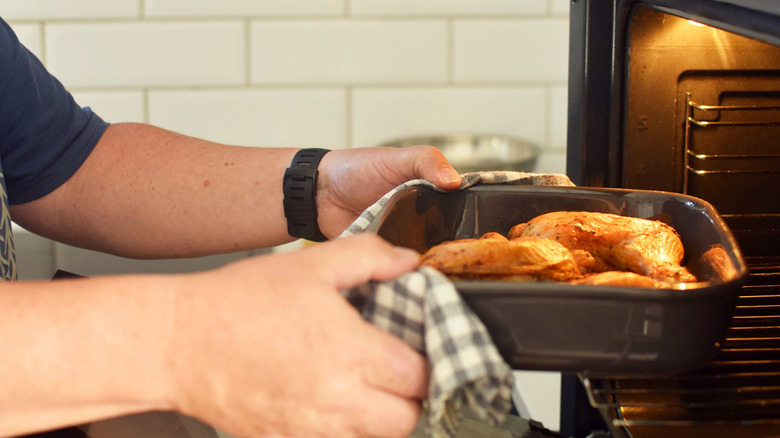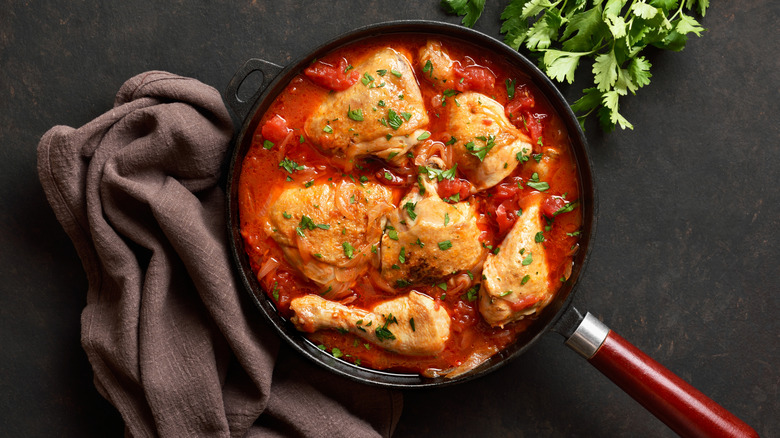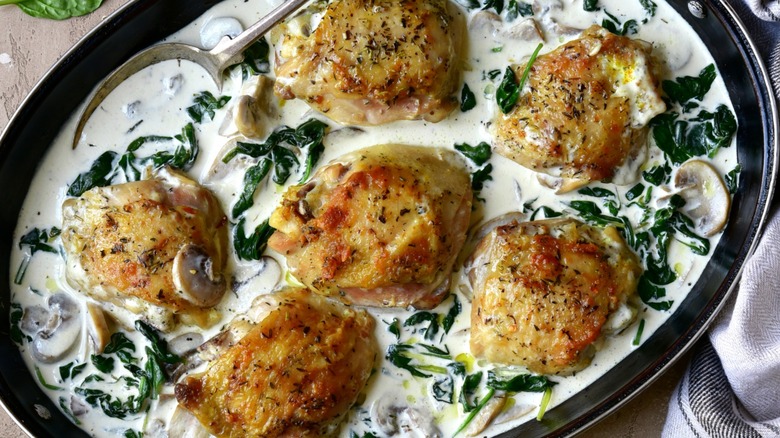11 Tricks For Cooking The Juiciest Chicken Thighs You've Ever Tasted
Many recipes feature chicken thighs. They are often viewed as the best cut for homemade chicken nuggets, are a favorite when making chicken noodle soup, and can taste amazing fried, with barbecue sauce, or when cooked in a slow cooker. However, while chicken thighs have the potential to turn out incredibly juicy and flavorful, most of us know they don't always live up to their potential.
Nothing is more disappointing than preparing a meal with chicken thighs only to dig in and taste something dry, tough, and disappointing. While cooking chicken thighs isn't an exact science, there are definitely things you can do to help ensure you prepare the juiciest poultry possible. Ahead, we'll take a look at some of the best tricks you can try — we'll cover selecting, prepping, and cooking the thighs, taking you through the process from start to finish. See what new ideas you can discover to up your chicken thigh cooking game.
Bone-in and skin-on thighs will turn out the juiciest
Your quest for the juiciest chicken thighs begins when you're at the grocery store. Picking up the right package of poultry can make all the difference. Choose a package with bone-in and skin-on thighs. Many people opt for boneless, skinless thighs — they're lured in by the prospect of not having to eat or cut around the bone. Others might not enjoy the taste of chicken skin. However, once you remove the skin and bones from the chicken thighs, you're increasing the likelihood they will become overcooked and dry.
Starting with bone-in and skin-on thighs helps to lock the moisture inside the chicken, which is precisely what you want to ensure they turn out juicier. If you don't want to eat the skin, that's fine — you can simply cut it off. And, the extra "hassle" of eating around the bone will be well worth the trade-off for the juicy and tender meat that will fill your mouth. Even better, boneless, skinless thighs are typically more expensive because of the additional labor that goes into removing the skin and bones. So, your wallet will be as happy as your taste buds.
Choose the best oven temperature
If you've ever had dry chicken, then you want to do everything you can to avoid leaving your chicken thighs overly dry. Unfortunately, this can cause many people to make the mistake of cooking them in an oven that simply isn't hot enough. You might assume a lower oven temperature is best to keep the meat from turning out overcooked and overly dry. However, this theory can backfire. When you cook chicken thighs in a cooler oven, say around 325 or 350 degrees Fahrenheit, they are going to take a longer time to cook. The longer they cook, the more likely it is that they will come out too dry.
Instead, cook your chicken thighs in a hotter oven. Set the temperature to about 425 degrees Fahrenheit. The thighs will cook more quickly, and thanks to their fattier consistency, won't have a chance to dry out (as would happen if you tried to cook chicken breasts in such a hot oven).
While we're on the subject of oven temperature and cooking time, let's also discuss the ideal internal temperature for chicken thighs. The USDA recommends cooking poultry to a minimum internal temperature of 165 degrees Fahrenheit. However, if you let your chicken thighs get even hotter, closer to 200 degrees Fahrenheit, you might find that it gets even more tender and juicier. The reason for this is that more of the collagen breaks down as they get hotter.
Cook the chicken thighs in fat to up the juiciness factor
When you want to keep your chicken thighs from drying out, you don't want to skimp on the fat. With more fat, the chicken will stay juicier and won't lose as much of its moisture. This is one of the reasons why cooking bone-in and skin-on thighs is better than using boneless, skinless ones: There will be more fat hidden under the skin to help lock in the moisture. And, when you cook the chicken thighs, the fat will surround the meat, effectively basting it and preventing moisture from being lost.
The fat that is naturally occurring on the chicken thighs isn't the only thing you can use to make sure they turn out wonderfully juicy. You can also add other fat, such as butter, oil, or mayonnaise, to the pan to help keep the meat perfectly hydrated. While mayo might seem like an odd choice, it can work wonders with chicken. The egg and oil in the mayonnaise will be absorbed by the chicken to keep it juicier.
Try the air fryer
If you haven't tried cooking chicken thighs in the air fryer, then you've been missing out. An air fryer cooks food differently than a conventional oven. These small countertop appliances have a fan that keeps the hot air moving around the basket or tray of food on the inside. The process results in crispy and delicious food — all achieved without the need for deep-frying the items in hot oil.
When you air fry chicken thighs — especially bone-in and skin-on thighs — the process will also help ensure the meat stays moist and flavorful. While an air fryer could potentially dry out leaner cuts of meat, fattier chicken thighs will come out perfectly juicy on the inside. You can try making "fried" chicken thighs by battering the meat — and making sure the breading doesn't fall off. Or, you could cook barbecue chicken thighs, teriyaki thighs, or simply season them with a little oil, salt, and pepper. The possibilities are really endless.
Try salting or brining chicken thighs before cooking them
Salt can be a powerful ingredient when you want chicken thighs — and other types of meat — to turn out juicy and flavorful. When you salt meat, the meat is better able to absorb moisture. If you guessed that this will result in a juicier chicken thigh, then you're right. Salt your chicken thighs a few hours before you plan to cook them to give the salt time to penetrate inside and start working its magic.
You can also consider brining chicken thighs to enhance their juiciness. Brining is simply the process of soaking meat in salty water, so it shouldn't come as a surprise that it delivers similar results to salting the thighs. When you brine chicken thighs, the salt will also break down the proteins, or denature them, helping ensure the finished chicken thighs retain more moisture for a perfectly juicy treat. You only need salt and water to make a brine, but you can also add other seasonings like garlic, thyme, or rosemary for some added flavor. Soak the chicken thighs in the brine for about an hour — too much longer than this, and they may pick up too much of the salt flavor and end up tasting saltier than you'd like.
Marinate the chicken before cooking it
The next time you want to ensure your chicken thighs turn out deliciously juicy, be sure to plan ahead and leave enough time to marinate them before cooking. Most marinade ingredients feature some sort of an oily or fatty ingredient. As you know, cooking chicken thighs in fat will help lock in their moisture and keep them from drying out. This is why mayo is one of the secret ingredients you will want to try marinating your chicken thighs in. Other marinades can also deliver when it comes to juiciness. For example, the marinade for Cuban mojo chicken uses olive oil, which is another fat that will help ensure the chicken stays moist.
In addition to delivering extra juicy chicken, marinating your thighs offers additional benefits. Marinades usually contain acid, which works to break down the proteins in the thighs. This will leave the thighs extra tender — a perfect accompaniment to the juicy meat.
Defrost thighs before cooking them
If you're in a rush to get dinner on the table and realize that you forgot to thaw those chicken thighs, it might be tempting to cook them from their frozen state. While this is technically an option, it isn't a good one if you want to make sure the thighs turn out as juicy as possible — because the inside of the frozen chicken will cook slower than the outside. The USDA says that it's safe to cook frozen chicken, but it says that it will take about 50% longer to reach the required internal temperature. This means if the recipe says to cook already thawed chicken thighs for 30 minutes, you'll need to leave about 45 minutes for the frozen thighs to cook.
If you decide to cook or grill the frozen chicken thighs, it is more likely that they'll end up dried out than if they were thawed. Your best bet is to thaw the chicken thighs before you cook them. Ideally, you should let them thaw in the fridge overnight. However, if you forgot to take them out of the freezer, you could also thaw them under cold — not hot — water.
When cooking chicken thighs on the stovetop, opt for a cast iron pan
You can make perfectly juicy thighs by cooking them on the stovetop. But the type of pan you use will impact how the chicken cooks — for best results, cook thighs in a cast iron pan.
Cast iron is known for its exceptional heat retention properties. This helps it sear the skin of the chicken thigh to get it nice and crisp while also locking in juices. In order for this searing to occur, however, it's important to make sure your pan is hot before adding the chicken. Heat the cast iron skillet over medium-high heat for several minutes. You'll know it's ready to use when you splash a few drops of water on the pan and then immediately sizzle and then evaporate. After cooking the chicken in the pan, give it a five-minute rest to make sure all the juices don't run out with your first bite or slice.
Know how to reheat chicken thighs without drying them out
So, you followed the tricks above and made wonderfully juicy and flavorful chicken thighs. Now, you have some leftovers you want to save for lunch or dinner the next day. If you want those juicy chicken thighs to taste as good as they did when they were fresh out of the oven or off the pan, then it's crucial to know the best way to reheat to avoid drying them out.
The optimal way to reheat chicken thighs can vary based on the cut of meat and how it was initially prepared. The best way to warm up fried chicken and bone-in/skin-on thighs is to use the oven. This method will help ensure the skin remains crispy and will heat the meat evenly, and prevent sections from becoming too dry. Put your chicken thighs in an oven-safe baking dish with about 1 cup of chicken broth, cover the dish with foil, and place it in a hot, 350-degree Fahrenheit oven. The foil and chicken broth will allow the chicken to retain its moisture. You can remove the foil after about 15 minutes and bake it uncovered for about five minutes to crisp the skin.
If you cooked boneless, skinless thighs, you'll want to warm them up on the stovetop for best results. This will warm them up more quickly, preventing the thighs from getting too dry with the longer heating time required by the oven (remember, boneless, skinless thighs don't have the extra fat to lock in the moisture that bone-in and skin-on ones do).
Pour sauce around chicken to help it stay nice and juicy
Use some sauce to help you make sure your chicken thighs come out of the oven tender, moist, and, most importantly, juicy. Place the already seasoned chicken thighs in the pan, and then pour the sauce around them — not over them — before putting the pan in the oven. As the chicken cooks, it will absorb some of the moisture from the sauce, resulting in a finished product that is super flavorful.
There is one key point here: Make sure you don't cover the chicken thighs with the sauce. Space them out in the pan such that the sauce will fill all the gaps between the pieces. Pouring the sauce over the chicken thighs may dilute or "rinse" away the seasonings you added. If you add too much moisture over the skin, it also won't crisp up nicely. And, let's face it, the crispy skin on a chicken thigh is almost as important as how juicy it is.
Cook chicken thighs in milk for a delightfully tender and juicy meal
When you're thinking about all the possible ingredients you might want to use cooking chicken thighs, milk is probably not one that comes to mind. However, if you overlook the potential benefits it can deliver to your finished chicken thighs, you'd be missing out. Cooking chicken thighs in milk can help tenderize the meat, ensuring they turn out incredibly moist and juicy.
As you probably know, milk is high in calcium. And when the calcium from milk comes into contact with chicken, it triggers an enzyme in the chicken, effectively tenderizing the meat. Buttermilk is more acidic, which can increase its tenderizing powers. Consider using buttermilk over regular milk to arrive at the juiciest thighs you could imagine. Add your favorite seasonings to the milk — garlic, sage, and rosemary come to mind — and create a rich and flavorful sauce that will also help keep the chicken from losing any of its moisture as it cooks.
